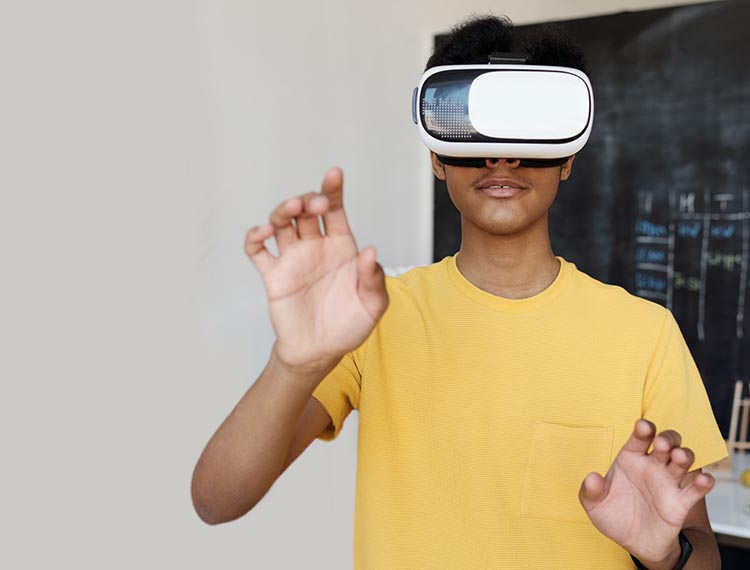6 Ways to Effectively Use Virtual Reality in Education

Virtual reality (#VR) technically refers to a computer-generated simulation, wherein an artificial surrounding comes into existence.
This realistic environment is accessible to the user in all directions and provides an immersive experience.
Naturally, educationists observed great potential in this technology and have, by now, made several attempts to successfully incorporate it into the classrooms and learning modules.
Here, in this compilation, we will look into some of the most effective implementations of Virtual Reality in Education.
1. Bring Destinations to Classrooms
Perhaps, one of the first aspects that seemed probable and promising to most educationists and trainers is to bring in complete destinations right to the four walls of the classrooms. Instead of disrupting a child’s learning rhythm with the field trip, they suggest using a virtual field trip.
On average, a regular field trip, i.e., one to the park or a movie, aims to freshen up the young minds and engage them in a lighter subject. However, the excessive involvement of the commute kills the gist of it. Plus, it demands an extra budget as well.
Virtual Reality, on the contrary, does the job in a matter of seconds. Using VR tools like Google Expedition, we can take the students to all places. The great part is it preserves the learning part. Plus, you can conduct multiple of these. And even offer the kids a real-life experience since VR enables interaction within landscapes and with objects.
2. Make use of 3D models
Another great way to effectively use virtual reality within the four walls of the classroom is to bring the textual content to life. Reading coordinates or lengthy descriptions demands twice as much input from the students’ end, as compared to the input required with effective use of VR.
Virtual Reality helps play the textual content in 3D in video and audio forms, making it easier to understand. It also contributes to picture memory. Thus, helping the students with better retention of knowledge.
Along with picture memory, we would recommend you encourage students to take notes irrespective of the impact VR has. The notes taken on their magnetic whiteboards and notebooks will keep them attentive and present in the lecture.
For example, anatomy students can study the complete skeleton, bones, muscles, and internal structure through the use of apps like Brain VR, 3D Organon VR, etc. Similarly, environmentalists and nature-enthusiasts can make use of apps like Discover VR. It provides complete videos about nature, the wild, animals, weather, and whatnot!
3. Incorporate Fun & Mysteries
Virtual Reality is pretty much fun already in comparison to the current static mode of learning. However, for the newer generation, the constant exposure to this latest tech may make it appear dull. And they may deviate from their learning modules.
To keep the hype and excitement alive, VR tools and apps also offer room for fun (incomparable fun, yes!). You could have them play around with mysteries like the Dark Room and a Fisher Man’s tale in their free lessons. These puzzle games boost cognitive thinking and the nature of VR tools handling will boost control on hand movements and enhance thought processes.
4. Keep a Balance between VR & Current model of Learning
As mentioned earlier, the current generation may lose interest in beyond-extraordinary experiences when provided constant exposure.
Thus, it is necessary to maintain a balance. In times when you’ve got a virtual reality activity planned, ensure there are a couple of lessons when students take out their textbooks to read and write.
5. Maximize Hands-On Learning
Virtual reality tools and apps also offer a great scope of hands-on learning, which, of course, has an ever-lasting impact. It helps the student learn more about the how’s and why’s than if and could.
Some VR technologies offer sensory experiences as well. Although it’s a bit costly, it enables the students to learn from a simulated real-life experience. For example, a textbook may not be able to tell that the smell of blood when stitching a patient may affect your performance level and stability. A simulated real-life experience, however, will not only unravel that. But also indirectly teach the student how to tackle the situation.
6. Remote Teaching & Learning
During the pandemic, we unveiled yet another valuable aspect of VR in the education sector, i.e., distance learning. When presented in physical classrooms became a point of the problem, Virtual reality bridged the gap and provided students and teachers to meet in virtual spaces. Here, the learning experience was no less than a physical classroom as the involved people could share their presentations, exchange opinions and ideas, discuss things, and whatnot.
Advantages of VR in Education
Given the effective uses above, Virtual Reality is far more engaging than the current forms of learning. It encourages student participation and compels the locked minds to step out and think. Previous studies suggest that students spend about one-fifth of their lecture time scrolling or browsing on their mobile devices (typically distracted!).
VR addresses this quite well. With so many things happening around, it is almost impossible for an eager student to get carried away by something else. A VR-based learning experience demands constant attention and participation.
In the lieu of it, students also discover their hidden capabilities and potentials. They master their existing skills. As they pay more attention to learning, and themselves, they unravel their true potential. Thus, it maximizes the learning output.
Final Thoughts
Virtual Reality is transforming the educational sector quite literally. We are stepping out from the pages and taking our learning experience to real-life, which, in turn, promotes the STEM and STEAM module of learning. Thus, giving birth to more practical minds than ever.
Arslan Hassan is an electrical engineer with a passion for writing, designing, and anything tech-related











Responses